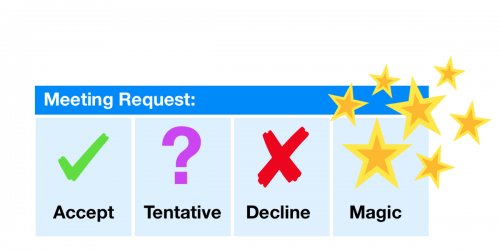- Time
- Set start and times then stick to them. People will learn to arrive on time.
- Resist the temptation to restate everything for latecomers - especially in online meetings.
- Try setting meeting durations in shorter default units - rather than think in 30 minute or 60 minute intervals try 20 and 40 minute meetings
- Review the impact meetings have on the rest of your productivity and schedule them to where they will do less damage to your plans ( try 3pm meetings rather than 10am). Do the same with the days you hold meetings. Monday morning meetings can be highly disruptive for example.
- Use non-standard start times for your meetings. Starting at quarter past or quarter to the hour makes the meeting time stand out - so people are more likely to arrive on time
- Scheduling back to back meetings is counter-productive. If one meeting over-runs the rest all go wrong too. Schedule non-meeting time into your day to create contingency and space to be productive
- Allow time to restate and recap agreements at the end of meetings
- Agenda
- Every meeting needs an agenda - even if it's informal. For one thing it is how people know whether or not they should attend. it also helps keep the meeting on track.
- Try a simple POST agenda. You can use this structure for a single topic meeting or revisit it for each sub-topic in a longer meeting:
- Purpose
- Objective (the outcome we expect)
- Structure (how we are going to tackle the topic)
- Timing - Tackle the most important or challenging topic first. If the meeting gets interrupted or runs out of time you will still have achieved the most important thing on your agenda.
- Avoid over-filling the agenda. Leave time for optional informal networking and updates at the end.
- Ensure your agenda stays action-oriented by naming each item using a verb followed by a noun. For example rather than an item called "Service Level Agreements" call it "Agree Service Level Agreements".
- Preparing yourself for a meeting
- Look at the agenda and ask yourself: What questions do I have and what answers do I need?
- Eat meals before or after, not during a meeting. Eating in a meeting is distracting for you and everyone else. Working lunches are good for building teams but but are not very productive in terms of tasks.
- Use the agenda to organise the list of agreed actions.
- Make sure any actions arising from the meeting are reviewed and agreed at the end of the session. These can also be written using the "verb followed by a noun" format. Get agreement on who will be doing the task and when it will be competed.
- People
- Use round-robin activities where everyone has to take turns and share their views/ideas on a topic. Make it more interesting by asking the last person to speak to pick the next person at random. This is more interesting than going round the table and means everyone has to pay attention. Repeat till everyone has spoken.
- If some people are not participating then ask the group to work in pairs and discuss the topic or question for a couple of minutes. When you bring everyone back together it will be much easier for people to take an active part. This can be very helpful if there are senior people present and this has caused some participants to keep quiet
- Before the end of a topic or meeting ask "Is there anything 'unsaid' about this that we should discuss before we move on. Then make time for unsaid comments to be shared.
- Give people jobs to do in the meeting such as ensure participation, track time, note actions. Change roles part way through longer meetings. Change seating too.
- Agree a house rule on how to deal with distractions caused by phones and laptops.
- The space
- Ideally meet at a round table - so everyone can participate equally and no one is sidelined. Seating in rows or around long, rectangular tables, often means people are left out or can avoid taking part.
- Try meeting without a table at all. Alternatively remove all the chairs. Standing for any length of time can help people remain concise.
- If you do have chairs remove any empty places at the table before the meeting starts.
- In longer meetings try using different parts of the room for different activities: discussion, brainstorming, action planning, presenting etc.
- If the meeting is made up of two or three participants you can try a walking meeting. Pick a pleasant route and have your discussion on the go.
- For remote meetings be extra clear about how to connect to the event. Make PIN numbers, links etc. very obvious. Have all meeting files uploaded and tested before the meeting starts
- Join remote meetings early so you have time to sort out any last minute technical issues
- Arrive at physical meetings early - if you're lucky you will get a meeting room to yourself for a short while. Use the time to process your emails and catch up on your reading/review tasks.
See also:
Training: Make meetings magic
Faculty: lead

